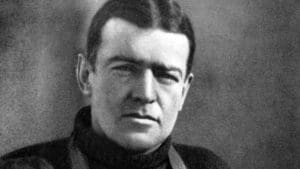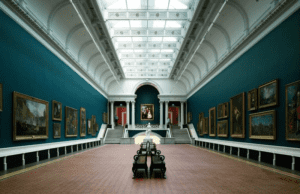Ancient Music: Uncovering the Secrets of Historical Soundscapes

Updated On: April 20, 2024 by Maha Yassin
Throughout history, ancient melodies and instruments have been forgotten, buried by the sands of time. In recent years, however, there has been a remarkable interest in bringing these lost sounds back to life. It involves meticulously researching historical texts, iconography, and other cultural artefacts. This revival serves a cultural purpose and adds richness to our contemporary musical landscape, allowing us to experience the past through sound.
Crafting replicas of ancient instruments and deciphering notation systems are central to this endeavour. Musicologists, historians, and luthiers collaborate to recreate the music once heard in ancient courts and communities. The resurrection of these instruments and melodies offers a uniquely intimate connection to our ancestors, fostering a deeper understanding of the human experience across different epochs.
Our approach to recreating ancient music demands a blend of creativity, scholarship, and technological innovation. The process spans from examining the significance of pitch and rhythm in the music of antiquity to leveraging modern technology to fill in historical gaps. Each discovery provides new insights into cultural exchange and the global interconnectedness of music throughout history.
Historical Context of Ancient Music
Before we delve into the historical nuances, we must understand that ancient music was not merely for entertainment. It was intertwined with culture, philosophy, and even mathematics, and its echoes can still be felt today.
Music in Ancient Civilisations
Ancient civilisations regarded music as a pivotal aspect of life, intertwined with religious rituals, festive celebrations, and daily activities. In ancient Egypt, music was fundamental in worship and processions, where percussion, wind instruments, and harps were prevalent. The Greeks, on the other hand, contributed significantly to music theory with the likes of Pythagoras who, through his mathematical lens, analysed the harmonic series and the relations between pitches that proved foundational for Western music.
Preservation of Musical Traditions
The preservation of ancient musical traditions has largely relied on archaeological findings and written texts. In Greece, musical notation was discovered, carved on stone or written on papyrus, providing a blueprint to reconstruct melodies unheard of in millennia. Thanks to these remnants, we can recreate sounds once integral to ancient societies. The revival of these melodies offers a deeper connection to the past, bridging the gap between historical scholarship and the sensory experiences of ancient times.
Revival Techniques and Musicology
In our quest to breathe life back into ancient music, we use sophisticated musicological research and analysis techniques to interpret historical musical notation accurately. As we embark on this journey to resurrect lost tunes, aspiring to be both authentic and enlightening, let us explore the essential roles played by musicology and the challenges of ancient notational systems.
Role of Musicology in Revival
Musicology is the backbone of our revival efforts, offering insights into the socio-cultural contexts of bygone eras. By studying the Cambridge Songs, a notable collection from the medieval period, we meticulously reconstruct musical traditions that were once integral to social and religious life. This research delves into historical documents, manuscripts, and artefacts, employing analytical tools to unearth a more faithful interpretation of ancient melodies for contemporary audiences.
Interpreting Ancient Musical Notation
The interpretation of ancient musical notation is a challenging yet rewarding endeavour. One such notational system we scrutinise is neumes, the earliest musical notation in the Western world, which often lacks precise rhythmic information. To decode these symbols, we analyse patterns, compare pieces, and sometimes make educated guesses about the rhythm and pitch. This often speculative process necessitates a combination of rigorous scholarship and creative conjecture to render the silent music of history’s pages audible.
Reconstructing Ancient Instruments
The journey to bring ancient music to life hinges upon the meticulous reconstruction of long-silent instruments. Our ability to hear echoes of the past relies on this craftsmanship.
Techniques in Instrument Reconstruction
Reconstruction of ancient instruments primarily involves historical research and analysis of artefacts. Archaeological evidence is scrutinised to uncover design and materials, while iconography and literary descriptions provide insight into the construction and sound of these instruments. Technological aids, such as 3D printing and computer modelling, offer modern means to recreate ancient sounds rapidly. The ASTRA project symbolises the successful merging of humanities and technology, enabling the reconstruction of instruments like the epigonion, an ancient stringed instrument, through digital simulations.
Examples of Reconstructed Instruments
The ancient world hosted a variety of unique instruments, each with its timbre and tone. Examples include the harpsichord, with its distinct plucked sound, and the aulos, akin to a double-reed instrument, both offer a glimpse into the musical sophistication of the past. The lyre, an essential instrument in Greek history, and the harp, often depicted in medieval imagery, are others that master craftspeople and historians have painstakingly brought back to life. Efforts like the Lost Sounds Orchestra utilise these reconstructions, delivering performances replicating ancient music’s resonance, as described in this ScienceDaily article.
Importance of Pitch and Rhythm

In exploring the realms of ancient music, two elements stand crucial: pitch and rhythm. They serve as the foundations upon which music is built, shaping its character and allowing it to traverse time and cultural boundaries.
Tuning and Tonality in Ancient Music
Ancient music’s essence hinged upon its tuning and tonality. Pitch sets the frequency at which a note vibrates, creating a tone that resonates with the listener. The vibration patterns, or tone, of ancient instruments often differed from those today due to variations in materials and construction. This distinct tonality offered a unique soundscape that connected listeners with past musical traditions. Tuning practices in antiquity varied greatly, setting the stage for what would later evolve into the harmonic structures we recognise in today’s music. These practices wouldn’t just impact the melodic lines and define the scales and modes used in composition.
Rhythmic Structures in Historical Context
Rhythm was pivotal in ancient compositions, infusing them with temporal structure and momentum. It is within this rhythmic structure where the heartbeat of ancient melodies can be appreciated, as each culture embellished its music with rhythms reflective of its societal norms and rituals. Recognising these patterns enriches our understanding of the music itself and provides insights into the civilisations that created it. Whether marked by percussive beats or the ebb and flow of a chant, rhythm maintains the flow of music through time, giving the listener a sense of the period’s approach to musical timing and pulse.
The Transcendence of Poetry and Music

In exploring the symbiotic relationship between verse and melody, we uncover the lasting impact of ancient poetry when fused with music.
Musical Interpretation of Ancient Texts
Throughout history, music has been a vibrant medium for reinterpreting poetic texts. Ancient Greece provides a particularly compelling example, with poetry from figures like Homer often composed for musical accompaniment. Though lost for millennia, the melodies have been subject to scrutiny and revival. Scholars have painstakingly reconstructed the music of Euripides’ Orestes, giving us a glimpse into the auditory landscape in which these ancient texts once resided.
Interpretations of ancient texts can be challenging as they require a deep understanding of the historical context, language, and musical systems used during that era. However, These attempts are vital to appreciate the full scope of the original works and acknowledge the central role that music played in ancient storytelling.
Poetry and Music in the Ancient World
Integrating music with poetic form was an artistic choice and a cultural practice that enhanced the storytelling experience. The works of Virgil and Horace are testaments to the rich interplay between the two arts. Virgil’s poetic compositions, for example, were often brimming with rhythm and could be seen as scores awaiting musical adaptation. Similarly, Horace’s works have an inherent musical quality that illustrates the inseparability of the two art forms within the context of ancient civilisations.
In the ancient world, poetry wasn’t meant to be merely read; its intended glory was revealed in performance—often with music—for these verses were crafted to transcend the written word, enveloping the listener in layers of expressive resonance. The tradition of combining lyrical poetry with music ensured that the essence of these narratives and the emotions they elicited would be passed down through generations.
Advancements in Musical Instrument Design
In examining the progression of musical instruments, we observe significant enhancements from their ancient forms to the sophisticated designs we see today. This section delves into the historical journey of instruments and the technological parallels that have shaped their modern incarnations.
Evolution from Ancient to Modern Instruments
The antiquity of musical instruments like the harp and flute reveals a rich history of cultural expression. Ancient harps, found in Mesopotamia as early as 3000 BCE, have evolved into the modern pedal harps with complex mechanisms allowing for key changes. Similarly, once made from bones or bamboo, the flute has transformed into the modern metal alloy flute with intricate key systems permitting a wide range of tones and dynamic control.
Comparative Study of Instrumental Technology
The violin presents a compelling study when comparing ancient and modern instrumental technology. It showcases the pinnacle of craft evolution, maintaining its essential form while embracing changes for enhanced sound and playability. Early violins were strung with gut strings, contrasting to today’s synthetic or steel strings, which provide consistent tone and durability. The fine tuners and chinrest added over time exemplify the minute technological refinements to improve the musician’s comfort and control.
Case Studies of Recovered Melodies

In the realm of historical music restoration, remarkable projects have succeeded in bringing ancient sounds back to life. We focus on two distinctive efforts that have reconstructed melodies lost over centuries.
Lost Songs Project
The Lost Songs Project has been a groundbreaking undertaking in music archaeology. A key highlight is music reconstruction from the 11th century, such as the “Cambridge Songs.” This project, involving extensive research, has enabled us to experience a brand of music unheard of for nearly a millennium. Performances of these restored works provide a profound connection to our musical past.
Modern Renditions of Medieval and Ancient Works
Among those dedicated to the revival of historical music is Benjamin Bagby, whose renditions of medieval works, including the epic Beowulf, are accomplished with musical and historical fidelity. Bagby’s ensemble, Sequentia, specialises in restoring and performing early music, such as Carmina Burana, using period instruments and informed techniques. Their performances offer an authentic taste of medieval and ancient music, immersing audiences in the sonic landscape of our ancestors.
Through these efforts, we are preserving the musical heritage and enriching our contemporary cultural landscape with the timeless beauty of melodies that once resonated throughout our history.
Cultural Impact and Exchange through Music
In music, the echoes of ancient melodies continue to resonate in today’s compositions, contributing to a rich cultural exchange that transcends time and borders.
Influence of Ancient Music on Contemporary Compositions
We find that ancient music has made a profound impact on contemporary compositions. Creators often integrate traditional melodies and rhythms into their works, forming a bridge between the past and present. For instance, folk tunes from Germany have been woven into modern musical theatre, bringing a sense of historical depth to recent productions. These ancient inspirations add complexity and authenticity to new compositions, nurturing a dialogue between different musical eras.
Cross-Cultural Exchanges in Musicianship
Cultural exchange through music is most vividly seen in the collaboration of artists from different backgrounds. With its lush harmonies and refined textures, French classical music has been especially influential as modern musicians incorporate French techniques into their practices. This synthesis of different traditions enriches the repertoire and fosters mutual respect and understanding among cultures, bearing witness to the power of music to connect us globally.
The Role of AI and Technology in Reviving Lost Music

Artificial Intelligence
We cannot travel back in time to experience the music of bygone eras in its original context, but technology offers us the next best thing. Artificial intelligence (AI) steps in as a digital time traveller, piecing together shattered fragments of musical history. By analysing patterns, structures, and styles within vast libraries of existing music, AI algorithms can generate compositions that mimic those long-lost melodies, giving us a glimpse into the musical heritage of the past.
Technology’s Contributions
Instruments and tunes that have faded into silence find a voice through digital restoration. Technologies such as AI reconstruct damaged musical pieces and separate and enhance elements from decades-old recordings. This has been demonstrated in projects like the AI-assisted restoration of The Beatles’ tracks, bringing to life the previously lost nuances.
AI-Driven Recreation
- Restoration: AI models detect and repair gaps in musical data.
- Reconstruction: Algorithms rebuild the structural integrity of compositions.
- Separation: Stem separation techniques isolate individual components for clarity.
Our approach to reviving ancient music is not rooted in altering history but in honouring its legacy through the tools at our disposal. AI acts as a bridge, connecting us to a past that can now resonate in the present, thanks to the use of AI technology in music sampling. We remain guardians of a cultural treasure trove, employing the latest technological advancements to ensure that history’s soundtrack is heard once again.
The Future of Ancient Music Revival

As we look to the future, the revival of ancient music holds promising developments for modern music, musicology, and education. With continued efforts in education and outreach, coupled with the potential for discoveries, ancient melodies and instruments may find a resonant place in our contemporary aural landscape.
Education and Outreach
We recognise the role of education in keeping ancient music alive. Innovative teaching methods incorporating ancient music into musicology courses could spark interest among young learners. Additionally, engaging outreach programmes have the potential to broaden audiences by connecting with people’s innate aural memory and their appreciation for the diverse origins of music. Workshops, interactive performances, and academic partnerships aim to educate and inspire a new generation of musicians and scholars.
Potential for New Discoveries
The hunt for musical antiquities is as thrilling as ever. Advancements in technology may lead us to uncover lost instruments or compositions, allowing us to reconstruct ancient sounds accurately. These finds will enrich our understanding of history and provide a fresh palette of sounds for modern music composers and performers. With each discovery, we bridge the gap between past and present, creating a rich tapestry of musical heritage for future enjoyment.
Notable Figures and Philosophies

In music’s past, certain individuals and ideas have played pivotal roles in shaping our understanding and appreciation of ancient melodies. Below, we explore the insights of early philosophers and spotlight the key contributors who have been instrumental in reviving what was once lost.
Ancient Philosophers on Music
The interplay of music and philosophy dates back to when melodies encapsulated more than mere entertainment. Roman philosopher Boethius was a cornerstone in this dialogue. His seminal work, The Consolation of Philosophy, delved into music’s ethical and metaphysical dimensions, asserting its potential to convey universal truths. Hailing from the regions of the Rhineland, his reverberations were felt throughout the scholarly circles of Europe, including academic institutions like Cambridge University, suggesting an enduring legacy that still informs contemporary understanding.
Contributors to the Revival Movement
Turning to the present, dedicated musicians and historians join hands in carefully reconstructing these ancient sounds. Examining texts such as The Consolation of Philosophy unlocks the tonal vocabulary of an era long past. The reconstruction process often sees them in dialogue with the remnants of musical notation and instruments, echoing the melodies that would have once filled venues from the Rhineland to the halls of Cambridge University. Their meticulous work is a testament to our collective determination to bring the musical heritage of our ancestors into today’s auditory landscape.

FAQs
In uncovering the rich tapestry of ancient music, we encounter numerous enquiries about how these historic tunes were once shared, the instruments that brought them to life, and their enduring legacy. We’ve compiled some commonly asked questions to clarify these fascinating subjects.
How were ancient melodies traditionally transmitted and preserved?
Historically, music was an oral tradition passed down vocally from generation to generation. Before the widespread use of musical notation, this was the primary method for preserving melodies, with variations emerging over time.
What instruments were primarily used in the creation of early music?
Early music saw the use of myriad instruments tailored to the era and region, such as the lyre in ancient Greece and various types of flutes and drums in numerous cultures. These instruments laid the foundation for musical development.
In what ways has early music influenced contemporary genres?
The echoes of early music resonate in contemporary genres through modal melodies, rhythmic patterns, and even instrumentation, providing a historical underpinning to today’s diverse musical landscape.
What methods are musicologists using to reconstruct melodies not preserved in written form?
Musicologists employ a combination of archaeological findings, iconography, and historical texts to hypothesise the structure and sound of lost melodies. At the same time, period instruments provide further insight into the music-making of those times.
Can we accurately replicate the sound of music from antiquity?
Though we strive for accuracy, it’s challenging to recreate the exact sound of ancient music. We rely upon instrument reconstructions and scholarly interpretations, providing approximate renditions.
What role did music play in ancient civilisations’ social and cultural practices?
Music was integral to ancient civilisations’ social and cultural rituals, serving as a medium for storytelling, celebration, and religious rites, reflecting the values and beliefs of the times.






